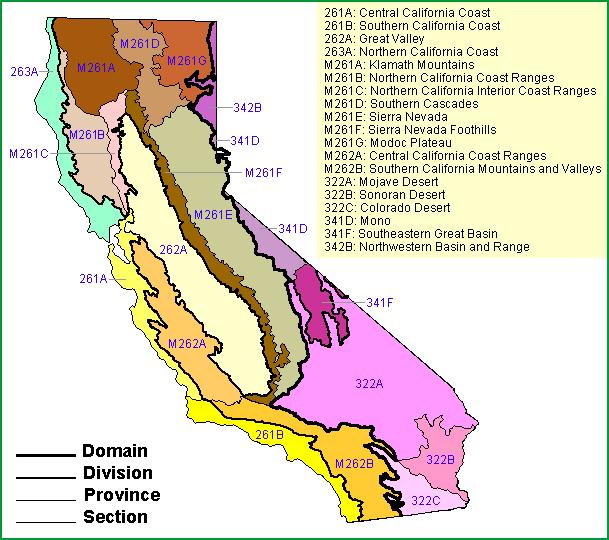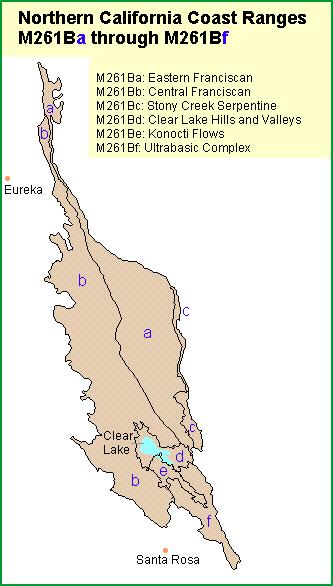 | Central Franciscan |
|
|
http://www.fs.fed.us/r5/projects/ecoregions/m261b.htm
Section M261B
Northern California Coast Ranges
This section is the interior part of the northern California Coast Ranges mountains, north of the Carquinez Straight. Marine air modifies winter and summer temperatures, but the section is inland from the coast far enough that oceanic effects are greatly diminished. The northern part is in MLRA 5 and the southern part in MLRAs 14 and 15.
Geomorphology. Parallel ranges, folded, faulted and metamorphosed strata; rounded crests of subequal height. Coast Ranges Geomorphic province.
Lithology. Late Mesozoic eugeosynclinal rocks of the Franciscan Formation, Mesozic ultramafic rocks, and Cenozoic volcanic rocks.
Soil Taxa. Alfisols, Entisols, Inceptisols and Mollisols in combination with frigid, mesic or thermic soil temperature regimes and a xeric soil moisture regime.
Vegetation. Predominant potential natural communities include the Douglas-fir - tanoak series, Blue oak series, Oregon white oak series, Chamise series, Purple needlegrass series, Mixed conifer series and White fir series.
The following series are found throughout the section and are not restricted to or extensive in any subsection. Series dominated by exotic plants are not listed under subsections unless they are extensive and stable.
Series dominated by exotic plants: Cheatgrass series, Kentucky bluegrass series and Tamarisk series.
Series that can occur in all subsections, but are not extensive: Bulrush series, Bulrush - cattail series, California oatgrass, Cattail series, Creeping ryegrass series, Duckweed series, Idaho fescue series, Mosquito fern series, Nodding needlegrass series, One-sided bluegrass series, Pondweeds with floating leaves series, Pondweeds with submerged leaves series, Quillwort series, Sedge series, Spikerush series, Tufted hairgrass series and Yellow pond-lily series.
Series restricted to riparian settings: Arroyo willow series, Black cottonwood series, Black willow series, Fremont cottonwood series, Mixed willow series, Mulefat series, Narrowleaf willow series, Pacific willow series, Red willow series and White alder series.
Disturbance series of short-lived vegetation: Blue blossom series, Coyote bush series, Deerbrush series, Eastwood manzanita series and Wedgeleaf ceanothus series.
Fauna. Mammals include black-tailed deer, black bear, mountain lion, coyote, bobcat and ringtail. Roosevelt elk, marten and fisher occur in the northern part of the section. Tule elk and mule deer occur in the southern part. Birds include eagles, hawks, owls, herons and osprey. Species of concern include marbled murrelet and northern spotted owl in the northern part.
Elevation. 300 to 8100 feet.
Precipitation. 25 to 120 inches.
Temperature. 35░ to 60░ F.
Growing Season. 80 - 250 days.
Surface Water Characteristics. Many rapid or moderately rapid rivers and streams in deeply incised canyons with weak bedrock channels flowing westerly to the Pacific Ocean.
Disturbance Regimes.
Fire: Historic occurrence has changed from frequent, low, moderate and high intensity surface fires to infrequent, high intensity ground or stand replacing fires.
Seismic Activity: Seismically active area with strong shaking and ground rupture.
Climate: Wide fluctuations in precipitation and temperature for periods of years result in significant or catastrophic changes in biological communities.
Land Use. Composition and successional sequence of some communities has changed because of plant and animal species introduced between the mid 1800Æs and early 1900Æs related to mining, grazing, forestry and recreational activities.
Cultural Ecology. Humans have been utilizing the area for about 10,000 years; the Northern Coast Ranges are the type location for the early, Borax Lake, Paleoindian component. Humans have been an integral part of Coast Range ecology for some 2,000 to 3,000 years. The diversity of Northwest California ethnographic cultures is the most complex in the United States, reflecting diverse prehistoric and historic uses, practices, and human adaptations. Contemporary attitudes and beliefs are dichotomized between emphasis on amenity/newcomer and commodity/long-time resident values, with all overlain by a rural lifestyle. The economy is relatively diverse - government employment, the timber industry, recreation, and agriculture.
Subsections. The Northern California Coast Ranges section is divided into 6 subsections
Map
Eastern Franciscan-Central Franciscan-Stony Creek Serpentine
Clear Lake Hills and Valleys- Konocti Flows - Ultrabasic Complex

